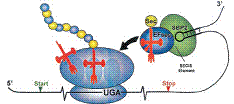Biochemistry, Department of

Vadim Gladyshev Publications
Document Type
Article
Date of this Version
June 2006
Abstract
Mouse models have been generated to assess the roles of selenoproteins involved with housekeeping tasks and/or stress-related phenomena in development and health. Each mouse model has taken advantage of the fact that the synthesis of all selenoproteins is dependent on the expression of two selenocysteine (Sec) tRNA[Ser]Sec isoforms that differ fiom each other by a single methyl group on the ribosyl moiety at position 34. The endogenous (Sec) tRNA[Ser]Sec population was selectively altered by generating mouse models involving 1) transgenic animals carrying mutant or wild type (Sec) tRNA[Ser]Sec transgenes, 2) conditional knockout animals carrying a floxed (Sec) tRNA[Ser]Sec gene that was targeted for removal in specific tissues and organs using loxP-Cre technology and 3) transgenic/standard knockout animals carrying mutant or wild type transgenes and a knockout of the (Sec) tRNA[Ser]Sec gene wherein the animal's survival is dependent on the transgene. These mouse models perturbed selenoprotein expression, often in a protein- and tissue-specific manner, permitting us to better assess their function in health and development.


Comments
Published in Selenium: Its Molecular Biology and Role in Human Health, Second Edition, edited by Dolph L. Hatfield, Marla J. Berry, and Vadim N. Gladyshev. Springer, 2006.